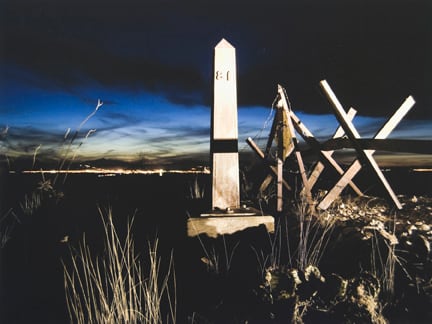David Taylor (American, born 1965)
Border Monument No. 81 (2008)
Archival Inkjet Print
24 x 31 inches
Gift of John Andrew MacMahon, Class of 1995
Rife with political tension, forgotten history, and environmental extremes, the US-Mexico border occupies a unique space physically and theoretically in the minds of many North Americans. While the media highlights the dramatic walls and fences that slice through the landscape, much of the border is open or minimally guarded. In reality, the US Border Patrol allows nature to perform much of its dirty work. The dry and exposed deserts and mountains along the border make up some of North America’s most extreme landscapes and inflict a severe toll on anyone who attempts to cross them. The intense walls fade into the dangerous wilderness, dotted every few miles with seemingly-random obelisks that serve as a monument to a forgotten time in this region’s geopolitical past.
In an attempt to highlight some of the unseen history and complexity of the border, David Taylor has made it his mission to document 276 of these obelisks, known as Border Monuments. These structures are remnants of the treaties following the Mexican-American War in the late 1800s. Before the increased militarization that dominates much of the border today, these simple cement spikes dotted the landscape, forming an invisible line between two nations. Taylor calls these obelisks “a monument to conquest,” citing how the US took over half of Mexico’s territory following the Treaty of Guadalupe Hidalgo.1 The artist recognizes that the perceptions of these monuments were vastly different depending on which side of the border someone lived. Taylor is also interested in how views of migration have evolved, especially as rhetoric infused with antipathy and nativism has become increasingly common in the United States.
With specific reference to just one of Taylor’s photographs in his series Working the Line, the photographer provides a glimpse into some of the often-overlooked nuances of the border in his image Border Monument No. 81. As the lit obelisk rises into the sky, several dichotomies stand out. Light competes with darkness. Nature competes with civilization. At the same time, the monument denoting treaties and agreements contrasts the military fencing behind it, suggesting that the region’s conflicts are far from settled. Beyond the frame of the image, another obelisk likely rises out of the ground. The monuments dot the landscape every couple of miles, meant to be seen from each other. Along the border, though, the landscape changes quickly, as the land’s topography and ecology operate with no regard for the arbitrary political lines.
The photograph’s power lies in its illumination of both historical and present narratives. While the border monument has remained a constant in this location for over a century, the world around it has changed. A seemingly dignified statue in the face of drug trafficking and immigration, the artist reminds us of the complexities of people and the easily forgotten history of conflict in the area. Even though this image is a mere snapshot in the night, Taylor uses it to encourage a more holistic appreciation of the border and its social and environmental implications, not just its negative stereotypes.
[1] Dart, Tom. “How the Original US-Mexico Border Markers Led to Decades of Fear and Antipathy.” The Guardian, December 11, 2017, sec. US news. https://www.theguardian.com/us-news/2017/dec/11/how-the-original-us-mexico-border-markers-led-to-decades-of-fear-and-antipathy.
-Paul Stouffer ‘21

